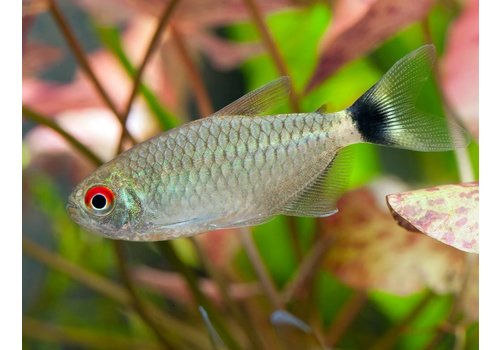

This is the part of red eye tetra care where you can get creative. You need accurate readings if you want your red eye tetras to thrive. pH levels: 5.5 to 8.5 (Stay close to 7.0 neutral)Īuthor Note: As always, invest in a reliable and accurate water test kit so you can check these parameters regularly.Water temperature: 72☏ to 84☏ (Around 79 or 80 degrees is ideal).As long as you stick close to the following parameters, you should be good to go! They’re adaptable to standard tropical tank setups.Īs a result, you don’t have to spend a ton of time ensuring that pH levels, temperatures, and hardness readings are in a precise range. While some other freshwater fish are sensitive to minute changes in water conditions, that’s not the case with these tetras. The best part of red eye tetra care is that these fish have relatively lax water requirements.
RED EYE TETRA ZIP
That size is suitable for a small group of about six fish.Īuthor Note: If you want to own more or make your red eye tetras a part of a larger community fish setup, go bigger! This species is active and will appreciate the extra swimming space to zip around during the day. Most experts recommend a tank that holds at least 20 gallons of water. Because red eye tetras are so small, they don’t need a ton of space to be happy! They can do just fine in relatively compact aquariums. One of the first crucial decisions you’ll need to make is how big of a tank you’ll need to get. To ensure that your fish live happy and healthy lives, here are some care guidelines you need to follow. Of course, red eye tetras have their preferences. They’re surprisingly resilient, making red eye tetra care very approachable for newer fish-keepers. If you’re interested in owning some red eye tetras for yourself, you’re in luck! These fish are very adaptable and can live in a wide range of conditions.

This measurement is from the tip of the tail to the snout.Īuthor Note: Some fish will get up to three inches long on rare occasions, but those instances are few and far between. The average red eye tetra size is around 2.75 inches in length for adults. Red eye tetras are on the smaller end of the size spectrum. Unsuitable living conditions, a lackluster diet, and a poorly designed home could lead to a shortened lifespan. Adult fish bought at a local pet shop could be several years old already, leading to a shortened lifespan in your home aquarium.įurthermore, red eye tetras are prone to disease and ill health with improper care. But as you probably know, there’s no guarantee. The average red eye tetra lifespan is around five years. The male fish also experience more color vibrancy around mating season while the females plump up with eggs. Typically, the females are a bit girthier than the males. This detail adds some contrast against the metallic scales.Īuthor Note: Red eye tetras exhibit some subtle sexual dimorphism. While the tips of the forked tail are transparent like the rest of the fins, a big black with a small highlight of white appears at the caudal fork. The caudal fin has some more distinct coloration. Like many types of tetras, red eyes have an expansive anal fin that stretches across the lower body. The fins are otherwise transparent, allowing the flashes of sparkle to stand out in the right lighting conditions. Iridescent highlights on the gill plate and fins are pretty common, too. Look closely, and you may notice some subtle color details.įor example, most fish have a splash of yellow tinge on the sides of the head. These fish have oval-shaped bodies covered in shimmery metallic scales. The heterochromatic nature of the eye is captivating, adding to the fish’s distinct look.Īs for the body, it’s a classic tetra shape. The rest is gray, matching the color of the body. Interestingly enough, only the top portion of the iris is red-colored. This species’ appearance is in its name! The most recognizable characteristic of this fish is its signature red eyes. Red eye tetra care is very straightforward, and this species has a lot to offer. It doesn’t matter whether this is your first time owning a tropical freshwater fish or you’re an experienced fish-keeper looking to add some vibrant beauty to a community tank. Their natural distribution is wide, leading to an adaptive lifestyle perfect for life in captivity. They’re most commonly found in calm rivers and streams throughout Paraguay, Peru, WWesternBrazil, and Eastern Bolivia. Red eye tetras come from warm bodies of water in South America. Pops of red, black, and white create a unique look that spices up any aquarium. Known for their shoaling nature, these fish can create flashes of shimmering metallic that move through your tank.


 0 kommentar(er)
0 kommentar(er)
